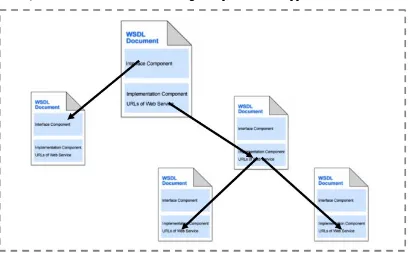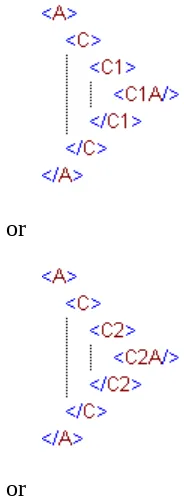OWS-Common WSDL Annex
(informative)
Guidelines for creating and using WSDL
A.1 General
The Web Services Description Language (WSDL) is an XML language for describing the computational characteristics of a web service: interface signatures, protocol bindings, and network endpoints. Version 1.1 was authored jointly by Microsoft and IBM and
published as a W3C Note in March 20011. Furthermore, WSDL 1.1 is recommended by
WS-I Basic Profile 1.2, which shall be used in conjunction with WSDL 1.1. WSDL 2.0 (formerly 1.2 by renamed because of its substantial differences from 1.1) has already been promoted to a W3C Recommendation but is not widely supported yet by standards and tools.
A.2 Relationship to OGC service descriptions
WSDL provides a formal interface definition language that complements the “human-readable” summary provided by the OperationsMetadata element in an OGC service description. Within a capabilities document, the <wsdl> element may be used to specify a reference to a WSDL resource, as shown in Listing A.1. If the service has a SOAP binding, there must be a <WSDL> element.
< ns:Capabilities>
Listing A.1: Element that refers to a WSDL resource
The value of the xlink:href attribute must refer to a web accessible WSDL document. The The style of this link is specified in section A3. The xlink:role attribute indicates the namespace of the document element; in effect this specifies the WSDL version (1.1 in Listing A.1). The xlink:show attribute has the value “none” to indicate that no specific
behaviour is intended—this is a simple link that should not be resolved to insert WSDL definitions into a capabilities document.
This approach enables OGC Web Services with SOAP bindings to be discovered via the GetCapabilities operation and to get additional information through the referenced WSDL file. On the other side a Web Service can also be discovered via an initial WSDL file and additional meta data can be obtained through the GetCapabilities operation described in the WSDL.
A.3 WSDL Publication
There are many ways to publish a WSDL file for a Web Service. The mainstream IT world has established three major ways:
• The WSDL file can be offered on the web site of the organization that publishes
the web service. This approach allows humans to find the WSDL file but is not sufficient for automatic use.
• The WSDL file can be published through public and private registries. UDDI
would be the choice for general Web Services and CSW for OGC Web Services. This approach follows the publish-find-bind pattern and thus allows humans and services to discover the WSDL file in a standardized manner.
• The web service itself can also publish the WSDL file. AXIS and the .NET
frameworks follow the convention of http://url:port/service/xx?WSDL. This is sufficient for a pragmatic approach, but fails for multiple WSDL files describing specific aspects of a Web Service as long as the base URL does not change.
Option number two can be combined with option number three by just pointing to the WSDL initially published via the ?WSDL pattern. Therefore, it is recommended to publish a single WSDL file as described in option three but ideally publish it through any kind of registry.
A.4 General authoring style
only the concrete part of the. Listing 2 shows an example. However, specific aspects of a service may also be described by separate WSDL files.
<wsdl:import namespace="http://www.opengis.net/wfs/responses"
location="http://foo.bar/wfs-responses.wsdl"/>
Listing A.2: Sample import of another WSDL
The result will be a directed acyclic graph of referencing WSDL files. Each node will be a part of a WSDL file and each arc a WSDL import. However, only the root element (WSDL) shall be visible from outside. Figure 1 presents this approach.
Figure A.1: Conceptual modularization of WSDL definitions
This approach allows the modularization of a WSDL file and therefore fosters reusability and cost effective maintenance and is especially a useful way to deal with application schemas and data views.
A.5 Late binding operations with WSDL
actual type of a (response) message depends on the request and therefore can only be determined at runtime.
To overcome these complementary approaches, this issue shall be solved on the message schema level rather than create multiple WSDL files or specific operations. Hence, a WSDL file shall include the response schema covering all potential output of a late binding operation. This response schema can be constructed using one or a combination of the following methods, because all described methods solve the problem on the schema level and only differ in terms of granularity of the response schema.
1) (OO-Aproach)
Create an abstract WSDL which defines a base type for concrete message schemas. These concrete schemas have to inherit this base type. This approach can be combined with option number two or three for the concrete part.
Example:
Figure A.2. Abstract WSDL message
Abstract specifications define the WSDL response message to a certain (common but
abstract) degree. In figure 1, the root element A and its child B are defined where B is
intended to be extended by concrete WSDL implementations. Figure 2 is a concrete
WSDL which specifies element E which extends the BType and therefore leads to a
more specific WSDL.
2) (Choice Approach)
Foresee all possible output schemas to a certain degree of detail. Use the xs:choice mechanism to describe all possible output schemas.
Example:
Figure A.4. Choice Approach.
Figure 3 shows an output message schema, which can have three different shapes:
or
Each specific solution can describes as valid output schema.
Figure 4 described the same approach, but in a combination with the previously introduced extension mechanism.
3) (Generic Approach)
Describe (or import from an already defined schema) the output schema to a certain degree of detail, and use xs:any as a wildcard to allow generic content. Please note, that xs:any leads to a weak contract and prevents automatic code generation in most cases.
Example:
Figure A.6. Generic Approach
Figure 5 shows the generic solution to the described problem. By using the xs:any mechanism, any content is allowed. Therefore, a weak contract is established between client and server because the concrete response schema cannot be determined. However, this mechanism can be more restricted by allowing only specific namespaces.
A.6 Request, Response Handling
A.6.1 XML Request/Response Messages
According to the WSDL 1.1 specification, the recommended way to invoke a service via SOAP document/literal-wrapped is to create a single part message as can be seen in exemplarily listing 3.
<message name="GetCapaMessage_POST">
<part name="request" element="wms:GetCapabilities"/> </message>
Listing A.1: Sample XML request message
The XML message may use a self defined element or simply reference the root element of an imported schema.
A.6.2 Binary Request/Response Messages
Messages with binary content shall be a single part messages using the an element either
imported or described in the <types> section and using type="xs:base64Binary". An
<types>
<schema…>
…
<element name="binaryPayload" type="xs:base64Binary"/>
</schema>
</types>
Listing A.4: Sample binary content definition
<message name="GetMapResult">
<part name="response1" element="tns:binaryPayload"/> </message>
Listing A.5: Sample plain binary message
A.7 SOAP Binding Descriptions
In the concrete WSDL part, the binding element shall reference the portType from the
abstract part and make use of the <soap:binding style="document"> binding as described
in the WSDL 1.1 specification. The operation element shall reference the corresponding
operation from the abstract part and use <soap:body use="literal"/> as input and output.
The <soap:operation> element shall be used according to the WSDL 1.1 and WS-I Basic
Profile 1.2 specifications. The soapAction attribute value shall follow the format:
http://www.opengis.net/<serviceType>/requests#<operationName>
An example is presented in listing 6:
<soap:binding style="document"
transport="http://schemas.xmlsoap.org/soap/http"/>
<operation name="GetCapabilities ">
A.8 Service Preconditions
WSDL as an integral part of the Web Service operational model, is sufficient for describing Web Service interfaces, but fails for defining access constraints and preconditions. Web Services Policy Framework (WS-Policy) is a standard to overcome these limitations. WS-Policy defines abstract XML policy elements which consist of a set of policy alternatives and are based on a set of policy assertions. A policy assertion can describe for instance required security tokens, supported encryption algorithms, and privacy rules. Other standards can extend these abstract policies with concrete polices. The Web Service Security Policy Language (WS-SecurityPolicy) specification allows the definition of concrete policies such as whether SOAP messages should be signed or encrypted and which algorithms should be used.



